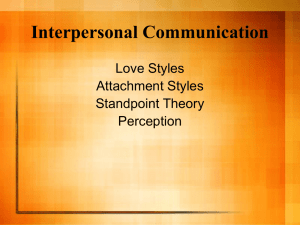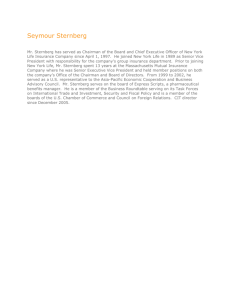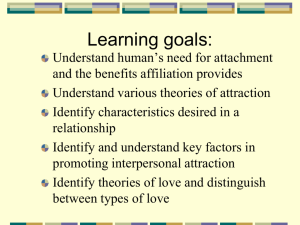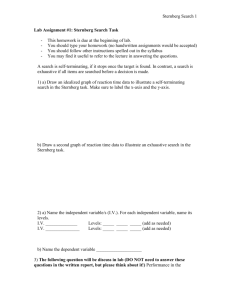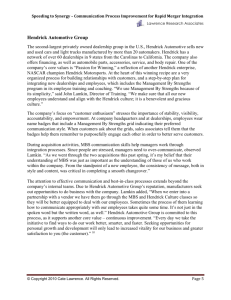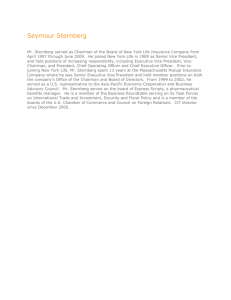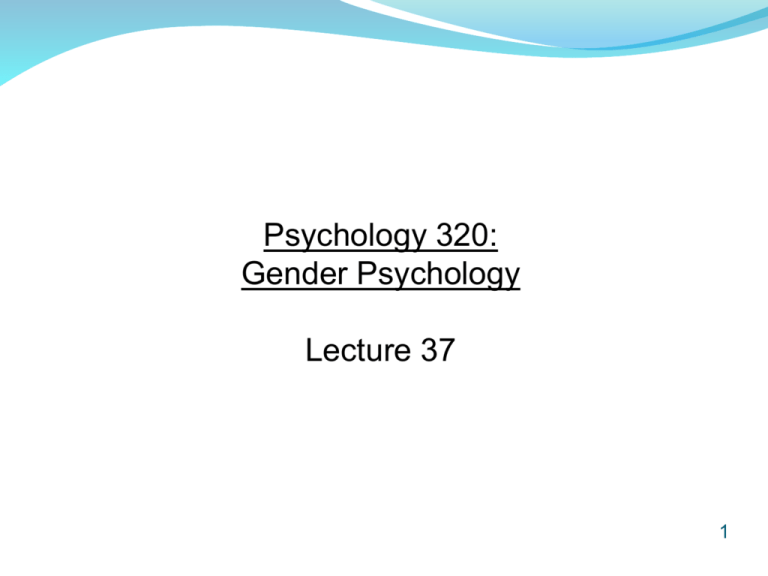
Psychology 320:
Gender Psychology
Lecture 37
1
Invitational Office Hour Invitations,
by Student Number for January 21st
11:30-12:30, 3:30-4:30 Kenny 2517
17206079
23110059
43514082
59225102
68751064
96286075
2
Romantic Relationships:
1. What characteristics do females and males desire in
a mate? (continued)
2. Are there sex differences in the experience of love?
3
By the end of today’s class, you should be able to:
1. identify sex similarities and differences in mate
preferences.
2. review theories of sex differences in mate preferences
and the research findings that support them.
3. discuss sex similarities and differences in Sternberg’s
components of love and Lee’s love styles.
4
What characteristics do females and males desire in a
mate? (continued)
• Explanations for sex differences in importance of
resource potential and physical attractiveness:
5
1. Evolutionary explanation: Emphasizes sex
differences in minimal parental investment.
2. Social role explanation: Emphasizes division of
labour between males and females in traditional
societies.
3. Social construction explanation: Emphasizes
social norms regarding desirable characteristics.
6
• Although sex differences consistently emerge with
respect to the importance of resource potential and
physical attractiveness, research indicates that these
characteristics are relatively unimportant to both sexes:
7
Hatfield and Sprecher, 1995
Assessed mate preferences in Japan, Russia, and
the US.
In all cultures, found that both sexes valued “internal”
attributes (e.g., kind) more than “external” attributes
(e.g., physically attractive).
8
* Significant difference.
Mate Preferences Among Males and Females
in Japan, Russia, and the US
(Hatfield & Sprecher, 1995)
9
• Moreover, research suggests that both sexes are
attracted to individuals who possess attributes similar
to their own.
Thus, research supports the “similarity-attraction”
hypothesis (vs. the “potential-attraction” hypothesis)
for both sexes.
10
Donald and
Melania Trump
Anna Nicole Smith and
Howard Marshall
Hugh Hefner and
Girlfriends
11
Angelina Jolie
and Brad Pitt
Danny Divito and
Reah Perlman
Beyonce and Jay-Z
12
Are there sex differences in the experience of love?
• Several theories of love have been proposed by
psychologists. Among these theories are:
13
1. Sternberg’s Triangular Theory of Love
Maintains that there are three components associated
with love: passion, commitment, and intimacy.
Identifies 8 types of love based on the presence or
absence of these components.
14
Intimacy
Passion
Commitment
Sternberg’s Triangular Theory of Love
(Sternberg, 1986, 1997)
15
Intimacy
Intimacy
Passion
Commitment
Size of triangle =
Amount of love
Passion
Commitment
Shape of triangle =
Type of love
16
Sternberg’s Taxonomy of Kinds of Love (1986)
17
Research has examined sex similarities and
differences with respect to Sternberg’s three
components of love:
Sternberg, 1997: F > M in intimacy, but F = M in
commitment and passion.
18
2. Lee’s Theory of Love Styles
Maintains that there are (a) three primary love
styles: eros, storge, and ludus, and (b) three blends
of love styles: mania, pragma, agape.
19
Agape
EROS
STORGE
Mania
Pragma
LUDUS
Lee’s Theory of Love Styles (Lee, 1973;
Hendrick and Hendrick, 1986)
20
Lee’s Taxonomy of Love Styles (Lee, 1973;
Hendrick and Hendrick, 1986)
Love Style
Description
Sample Item
Eros
Romantic and passionate
love.
I feel that my lover and I were meant
for each other.
Storge
Friendship love.
It is hard to say exactly where
friendship ends and love begins.
Ludus
Game-playing love.
I try to keep my lover a little uncertain
about my commitment to him or her.
Mania
Manic, dependent, and
possessive love; blend of
eros and ludus.
When I am in love, I have trouble
concentrating on anything else.
Pragma
Practical (“shopping list”)
love; blend of storge and
ludus.
I consider what a person is going to
become in life before I commit myself
to him or her.
Agape
Pure and altruistic love; blend
of eros and storge.
I would endure all things for the sake
of my lover.
21
Research has examined sex similarities and
differences with respect to Lee’s love styles:
Hendrick and Hendrick, 2002; Lacey, 2004: F >
M on storge and pragma; M > F on ludus and
agape.
Research has also examined the correlation
between self-esteem and Lee’s love styles:
Hendrick and Hendrick, 2002: Positive correlation
with eros and ludus; negative correlation with mania;
no correlation with storge, pragma, and agape.
22
Romantic Relationships:
1. What characteristics do females and males desire in
a mate? (continued)
2. Are there sex differences in the experience of love?
23


